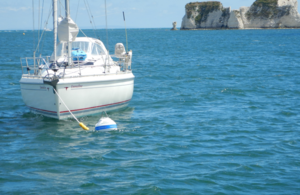Studland Bay Marine Partnership
Delivering innovative conservation projects to protect Studland Bay바카라 사이트ôs vital seagrass habitat while working closely with the local community and water users.

Vessel using ecomooring at Studland in Dorset courtesy of Boatfolk.
Key facts 
-
Applicant name: Studland Bay Marine Partnership and Dorset Council. 
-
Location:  Studland Bay, Dorset. 
-
Type of project: Marine conservation, community engagement and sustainable mooring solutions. 
-
Project value: £262,000 
-
Grant value: £196,000 
-
Date awarded:  November 2023  
Project details 
Studland Bay is home to Dorset바카라 사이트ôs most extensive seagrass beds which serve as an important habitat for rare or endangered species of seahorse, pipefish and rays, as well as nursery grounds for commercially important fish species. It was formally designated a Marine Conservation Zone (MCZ) in the 2019 and in 2021 MMO introduced a voluntary no anchor zone (VNAZ) to help protect the seagrass habitats.¬†¬†
During 2021 The Studland Bay Marine Partnership (SBMP) was established, bringing together the local community, to protect the area바카라 사이트ôs seagrass habitat while balancing the needs of recreational boaters, visitors and businesses. This included awareness raising campaigns and the installation of eco-moorings, an environmentally friendly alternative to traditional moorings.¬†
To further these efforts, £186,000 was awarded through the Fisheries and Seafood Scheme to support the installation of an additional 57 new eco-moorings, bringing the total number available in the bay to 87 during the main boating season. Funding also supported ongoing research and monitoring, and an expanded community engagement programme. 
David Brown, Chair of the Studland Bay Marine Partnership (SBMP), said:  
바카라 사이트úThe funding from FaSS has enabled us to implement practical solutions that have made a positive impact towards the conservation of Studland Bays바카라 사이트ôs special marine ecosystem. It is also enabling us to continue the important work of conserving and preserving the seagrass habitats for future generations to enjoy. 바카라 사이트ė바카라 사이트ô¬†
Cllr Jon Andrews, Dorset Council바카라 사이트ôs Cabinet Member for Place Services, said:¬†
바카라 사이트úWe are delighted that we successfully secured funding to aid conservation initiatives in Studland Bay, as safeguarding our remarkable coastline and the habitats it nurtures is of huge importance. Studland Bay holds immense value 바카라 사이트Ē not only for the diverse wildlife of our county but also for the local community, businesses, and water enthusiasts who treasure it. This funding will play a pivotal role in supporting the Studland Bay Marine Partnership바카라 사이트ôs collaborative and sustainable approach to managing the area effectively.바카라 사이트̬†
Project outcomes 
-
Installation of 57 new eco-moorings, expanding the environmentally friendly anchoring options for recreational boaters in Studland Bay.  
-
Ongoing research and monitoring to track seagrass recovery. 
-
Delivery of community engagement activities to raise awareness of Studland바카라 사이트ôs seagrass habitat and the importance of the voluntary no anchor zone.¬†¬†
-
Provision of new information, signage and resources for boat users at local marinas and harbours to promote responsible anchoring and conservation-friendly practices.  
-
Formalisation of the Studland Bay Marine Partnership, ensuring its long-term role as a collaborative, community-led group balancing environmental protection with recreational use.  
Supported outcomes 
-
Enhanced visibility for eco-moorings and their benefits through public engagement events, resulting in the eco-moorings featured on BBC Springwatch and Crown Estate project showcase. 
-
Annual MMO led VNAZ reviews indicating number of recreational boaters anchoring in areas of seagrass is continuing to decrease over time. 
-
A 2024 University of Southampton research and monitoring dive which has observed seagrass regrowth in the bay. 
Learn more 
Find out more about the  
View more case studies here: Fisheries and Seafood Scheme: Selected case studies